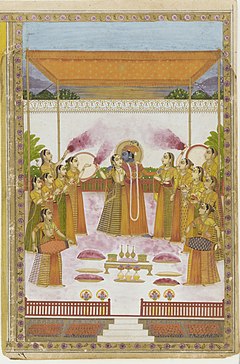A | B | C | D | E | F | G | H | CH | I | J | K | L | M | N | O | P | Q | R | S | T | U | V | W | X | Y | Z | 0 | 1 | 2 | 3 | 4 | 5 | 6 | 7 | 8 | 9
| Holi | |
|---|---|
 | |
| Observed by | Hindus,[1] Jains,[2][3] and others[4] |
| Type | Religious, cultural, spring festival |
| Significance |
|
| Celebrations | Night before Holi: Holika Dahan or Kama Dahan On Holi: Playing with coloured powder and water, dancing, greetings, festival delicacies[5] |
| Date | Phalguna Purnima |
| 2025 date | 14 March in India[6] 24 March in Nepal (hilly region) 25 March in Nepal (terai region)[7][8] 24 March in Nepal[9] |
| Frequency | Annual |
| Related to | Hola Mohalla, Shigmo and Yaosang |
Hindu festival dates The Hindu calendar is lunisolar but most festival dates are specified using the lunar portion of the calendar. A lunar day is uniquely identified by three calendar elements: māsa (lunar month), pakṣa (lunar fortnight) and tithi (lunar day). Furthermore, when specifying the masa, one of two traditions are applicable, viz. amānta / pūrṇimānta. If a festival falls in the waning phase of the moon, these two traditions identify the same lunar day as falling in two different (but successive) masa. A lunar year is shorter than a solar year by about eleven days. As a result, most Hindu festivals occur on different days in successive years on the Gregorian calendar. | |
| Part of a series on |
| Hinduism |
|---|
 |
|
Text je dostupný za podmienok Creative
Commons Attribution/Share-Alike License 3.0 Unported; prípadne za ďalších
podmienok. |

